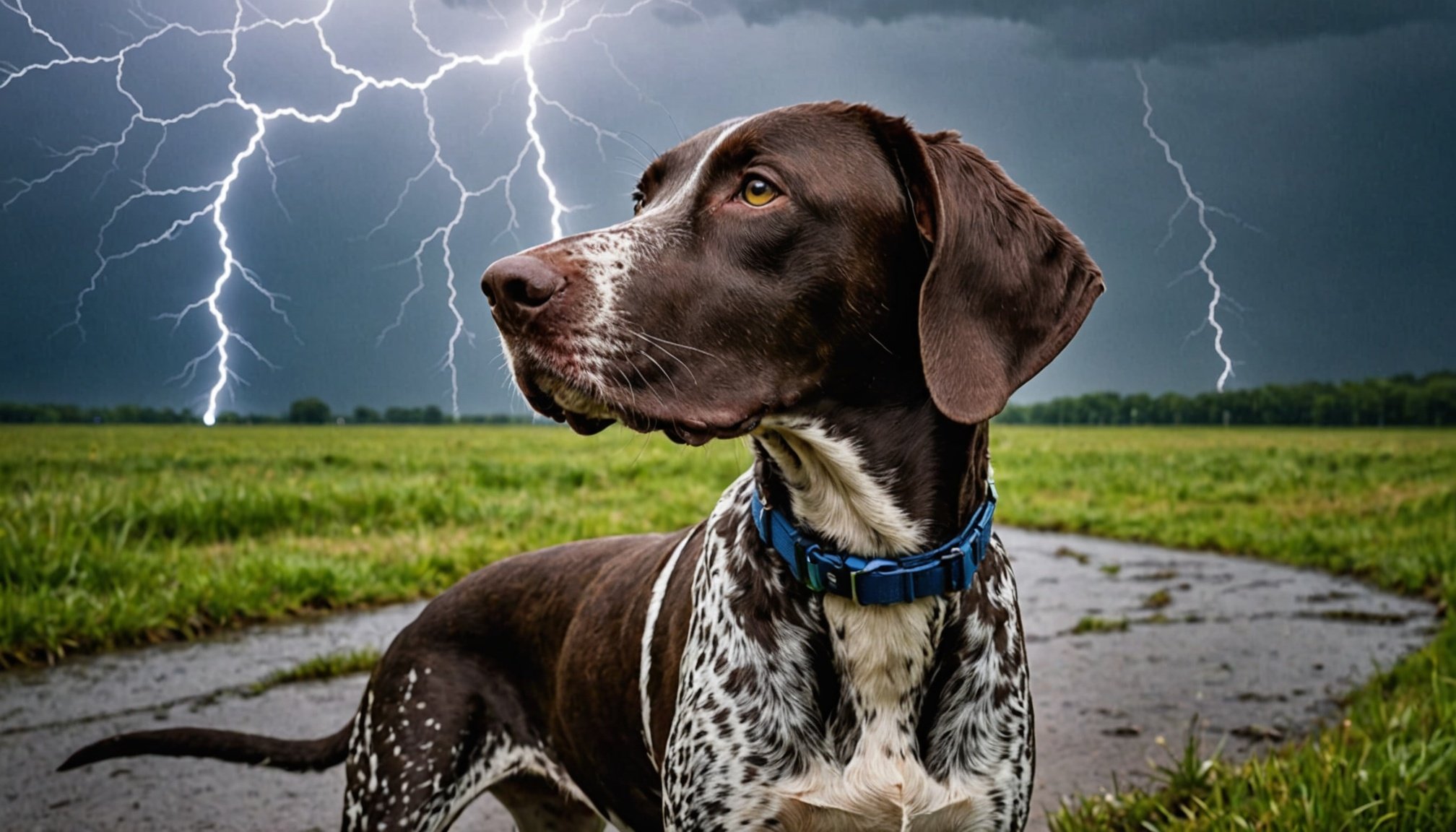Understanding Thunderstorm Anxiety in Dogs
Thunderstorm anxiety is a prevalent issue among dogs, and understanding its causes is essential for helping your pet. The causes of anxiety in dogs during thunderstorms often relate to their heightened sensitivity to noise and changes in atmospheric pressure. These factors can provoke reactions ranging from mild discomfort to intense fear.
Certain breeds, such as the German Shorthaired Pointer, may exhibit specific behaviors when facing thunderstorm-related fear. This breed, known for its keen senses, might become agitated or overly alert due to their responsiveness to changes in their environment—potentially intensifying their fear response during a storm.
Dans le meme genre : Mastering Trick Training: Top Techniques for Teaching Your Bichon Frise to Shine
Recognising the signs of anxiety and fear in dogs is crucial. You might notice symptoms such as trembling, pacing, panting, or hiding. In severe cases, some dogs may even attempt to escape or destructively chew objects to cope with their distress.
Understanding these underlying causes and identifying the triggers can aid in managing thunderstorm-related anxiety in your dog. Creating a safe environment or employing calming methods can significantly ameliorate their stress during stormy weather. Recognising these signs early will empower you to take proactive measures to ease your dog’s thunderstorm anxiety.
A lire aussi : Ultimate Guide to Safely Removing Burrs from Your Wirehaired Pointing Griffon”s Coat
Creating a Safe Space for Your Dog
Providing a safe space for dogs is paramount in ensuring their well-being. A dedicated comfort zone offers relief from anxiety and stress, vital for a happy pet. Recognising the necessity of such a space involves understanding your dog’s unique needs and preferences.
Designing this area requires careful consideration. Begin by choosing a quiet corner, away from high foot traffic and noise. This tranquil setting is fundamental for effective anxiety relief. Integrate familiar scents and objects to evoke a sense of safety and reassurance. Items imbued with your scent, like an old t-shirt, can be comforting.
The setup should include a cozy bed, allowing your dog to relax and unwind. Add their favourite toys to complete the comfort zone. Maintaining a consistent routine in this area reinforces safety. Introducing anxiety relief tips, like using calming sprays or music, can further enhance the environment.
Incorporating these elements establishes a retreat, crucial for dogs dealing with stressors like thunderstorms or separation anxiety. Be responsive to your dog’s reactions and adjust the space as needed. This empathetic approach fosters a nurturing haven, instrumental in your pet’s emotional health.
Calming Products and Techniques
Dog owners often seek effective calming products to alleviate their pets’ anxiety. Various products, such as calming wraps and sprays, offer practical solutions. Calming wraps apply gentle pressure to the dog’s body, much like a comforting hug, helping to soothe anxious behaviours. Similarly, calming sprays contain ingredients such as lavender or chamomile, known for their relaxing properties.
Natural remedies offer another avenue for anxiety relief, appealing to those who prefer a more holistic approach. These may include herbal supplements or the use of essential oils like valerian root or passionflower. Such remedies can be administered in various forms, from treats to topical applications.
Techniques like playing calming music or nature sounds can be particularly effective. Gentle melodies or recordings of flowing water and bird songs create a serene environment that can reduce stress in dogs. Adjusting the volume to a level that’s comfortable for your pet is key, ensuring the sounds are soothing rather than overwhelming.
When selecting a calming method, consider your dog’s specific needs and preferences. Experimenting with different anxiety relief techniques and products can lead to finding the most effective solution for your furry friend’s well-being.
Behavioral Training Strategies
Understanding dog training techniques such as desensitization and counter-conditioning can be essential for managing canine fears, such as those associated with thunderstorms. The process of desensitization involves gradually exposing your dog to the stimuli they fear, such as the sound of thunder, at a low intensity that doesn’t provoke anxiety. Over time, the volume is increased in a controlled manner, helping the dog to become accustomed to these sounds in a safe setting.
Counter-conditioning complements this by pairing these exposures with positive experiences. For instance, offering your dog treats or engaging in play when they hear thunder can reinforce positive associations with the sound. This can help in changing the dog’s emotional response from fear to comfort when thunderstorms occur.
The importance of consistent training cannot be overstated. It is critical to ensure that these strategies are applied regularly and with patience. Gradual exposure is key, as rushing the process could exacerbate the problem. Effective dog training techniques aim to build your pet’s confidence and help them manage anxiety better, leading to a more relaxed and happier canine companion during such events.
Expert Recommendations and Resources
When managing storm anxiety in dogs, balancing expert dog training advice with veterinary tips is essential. Experts recommend consulting behavioral specialists who can guide customised plans suited to individual canine needs. Addressing anxiety often requires insights from both veterinary consultations and expert evaluations, as these professionals can suggest techniques like counter-conditioning using positive reinforcement to alleviate stress.
Veterinary tips often point out the significance of early intervention, ensuring that your pet’s anxiety is addressed before it escales into a more significant issue. Consultation with a vet can be vital in determining if treatment with medication is warranted, especially for severe anxiety cases. Most veterinarians can also suggest reputable behavioral specialists or programmes that offer detailed plans specifically aimed at reducing anxiety.
Online resources further broaden the support network available to pet owners. Numerous platforms provide articles, forums, and expert-guided seminars on storm anxiety management. Engaging with these online communities offers shared experiences, lending a hand to owners seeking reassurance and additional advice. Importantly, these resources are more than supplementary; they actively equip pet owners with a wider understanding of anxiety management techniques, paving the way for effectively calming their furry companions.
Frequently Asked Questions (FAQ)
Navigating the intricate world of dog anxiety questions is no small feat, especially when it comes to natural fears like thunderstorms. Many pet owners find themselves pondering, “Why does my dog tremble during a storm?” The answer lies within the dog’s heightened sensitivity to atmospheric changes and noises, often elevating to full-blown thunderstorm fears. Dogs perceive these noises differently than humans, causing elevated stress levels and anxiety.
Pet owner concerns often revolve around effective management of their pet’s anxiety. Quick solutions can be life-changing. One simple tip is creating a safe, cosy space where your dog feels secure. Additionally, distraction through favourite toys or calming music may help.
For more severe cases, some might contemplate professional intervention, such as veterinary medications. It’s crucial to consult a vet, who can prescribe and regulate medicine aimed specifically at easing anxiety symptoms in pets. This is important as inappropriate use of medication can inadvertently exacerbate anxiety problems.
Understanding these facets not only equips pet owners with the tools to manage thunderstorm fears, but also ensures happier, healthier pets when the skies grow stormy.










